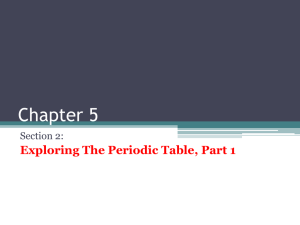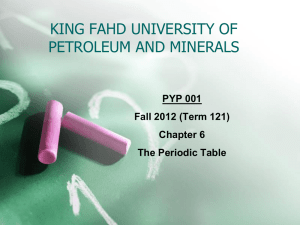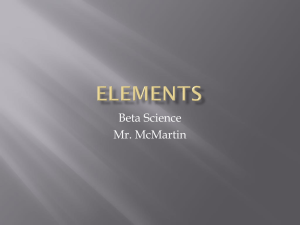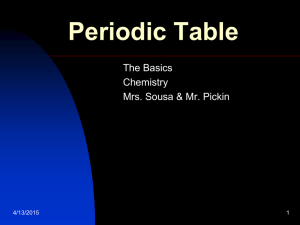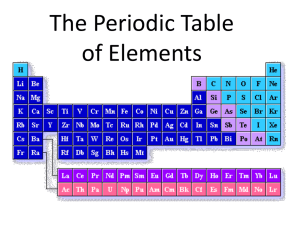3.2 PowerPoint
advertisement
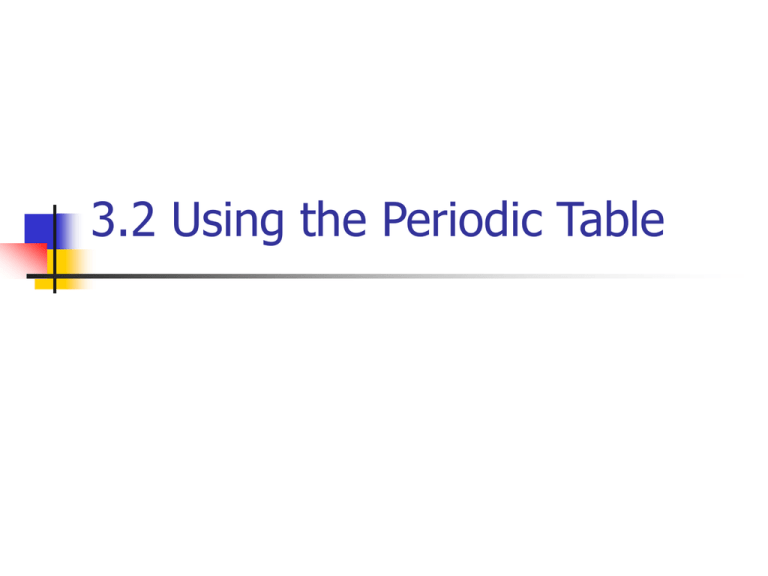
3.2 Using the Periodic Table Objectives Relate an element’s valence electron structure to its position in the periodic table. Use the periodic table to classify an element as a metal, nonmetal, or metalloid. Compare the properties of metals, nonmetals, and metalloids. New Vocabulary to Look for… Period Group Noble gas Metal Transition element Lanthanide Actinide Nonmetal Metalloid semiconductor Relationship of the Periodic Table to Atomic Structure Periodic tables contain a vast array of information on the elements. You will learn to use the periodic table to gather information about the elements and group of elements we are studying. Modern periodic table is arranged according to increasing atomic number. What information does the atomic number tell us? Periods and Groups The horizontal rows of the periodic table are called periods. The vertical columns are referred to as groups. Groups are also called families of elements. Elements in the same group have similar properties. Atomic Structure of Elements Within a Period Each period starts with a group 1 element, which has 1 valence electron. As you move across a period the number of valence electrons increases. Moving from 1, 2, 13, 14, 15, 16, 17, 18. Group 1 elements have one electron at a higher energy level than the noble gas of the preceding period. Atomic Structure of Elements Within a Group The number of valence electrons can be predicted using the periodic table. Group 1 has 1 valence electron Group 2 has 2 valence electrons Groups 13-18 have the second digit of valence electrons. 13 has 3 valence electrons 14 has 4 valence electrons Fig. 3.8 p. 98 Noble Gases Group 18 have the periodic table. They have 8 valence electrons, except for He which only has 2 Full energy levels Generally unreactive or inert Ne, He, Ar Noble Gases Halogens Greek meaning “salt former” Form salt like compounds Group 17 7 valence electrons F, Cl, Br, I Alkali Metal Group 1 (except H) 1 valence electron Li, Na, K Alkali Metals Alkaline Earth Metals Group 2 2 valence electrons Be, Mg, Ca, Ba Valence Electrons-Properties Valence electrons help to determine the physical and chemical properties Groups have similar properties b/c they have the same number of valence electrons Fig. 3.9 p. 99 Electrons in Energy Levels-Group 16 Physical States and Classes of Elements Physical States of the Elements The physical states of the elements are show on the periodic table on p. 92-93. Most elements are solids at room temperature Only two are liquids. What are they? A. B. All the gases except hydrogen are in the upper right corner of the table. List some. Gallium Classifying Elements Elements are classified into groups Majority of elements are metals Left side and center Nonmetals Metals Nonmetals Metalloids Upper right corner Metalloids Along the boundary b/t metals and nonmetals Metals Have luster Conduct heat Good conductors of electricity Most have high boiling pts. Malleable Ductile Most are solid Only one metal is in the liquid state. Metals Most are located in Groups 1-13 Transition Elements- Elements in Group 312 (all metals) Iron (Fe), nickel (Ni), Copper (Cu), Zinc (Zn) Some of period 7 are synthetic and radioactive The transition elements have a less predictable behavior and properties than the other metals Transition Elements Transition Elements Transition Elements Metals Elements with the atomic numbers 5871 and 90-103 are placed below the main table If they were part of the main table it would be extremely wide Known as the inner transition elements Many were unknown in Mendeleev’s time Inner Transition Elements Lanthanides First series of inner transition elements 14 elements 58-71 Also called rare earth elementsabundance 0.01% All have similar properties Actinides Second series of inner transition elements 90-103 Radioactive None beyond uranium occur in nature Unpredictable-complex structures Nonmetals Nonmetals are abundant in nature Oxygen and nitrogen make up 99% of our atmosphere Carbon is found in more compounds than all the other elements combined. Nonmetals Don’t conduct electricity Poor conductors of heat Brittle when solid Many are gases at room temp. Solids lack luster Melting points and boiling points are low Table 3.5 p. 105 Properties of Metals and Nonmetals Metalloids Have properties of both metals and nonmetals Located between the metals and nonmetals Si, Ge and As are semiconductor Does not conduct electricity as well as a metal, but does better than a nonmetal Si semiconductors made the computer revolution possible. Atomic Structure of Metals, Metalloids and Nonmetals Differences occur b/c of the different arrangements of electrons Number, arrangement of valence electrons along with how tightly they are held in the atom determines the behavior. Valence electrons in Metals Loosely bound Free to move in the solid metal Easily lost Freedom of movement = conductivity Valence electrons in Nonmetals and Metalloids Tightly held Not easily lost Chemical Reactions and Electrons Metals tend to lose valence electrons Nonmetals tend to share or gain electrons General Properties and Uses of Metals, Nonmetals and Metalloids Familiar Metals 1. Some Lanthanides and Actinides 2. Compounds of europium and ytterbium – picture tubes of TV Neodymium – high powered lasers Carbon and Some Other Nonmetals 3. Carbon: Coal, natural gas, oil, graphite, diamonds Bromine and Iodine – halogen lamps Metalloids 4. Jewelry, figurines, electrical circuits Silicon – electronic devices Page 106-107 Semiconductors Metalloids that do not conduct electricity as well as metals, but better than nonmetals Uses Television Computer Handheld electronic games Calculators Semiconductors –Electrons and Electricity An electrical current is flowing electrons. Metals conduct electricity well because the electron are not tightly held by the nucleus and are therefore free to move. Copper wire At room temperature Si is not a good conductor. Its four electrons are tightly held by the nucleus. In order to make it a good conductor it must be doped with another element. Silicon (Si) Doping of Si By adding small amounts of P to Si a good conductor is created. P has five valence electrons. This adds an extra electron which is free to move = electrical conductivity. n-type semiconductor (negatively charged) Doping of Si By adding B to Si a good conductor is created B has three valence electrons. The shortage of electrons creates “holes” in which the electrons can move = electrical conductivity. p-type semiconductor (positively charged) Diodes The combination of n-type and p-type semiconductors is a diode. Permits electrical flow in only one direction Negative terminal to positive terminal Transistors Key components in electrical circuits, amplifying the electrical signal. npn-junction pnp-junction Review 1. 2. 3. Where are the halogens, noble gases, alkali metals, alkaline earth metals, lanthanide and the actinides located? Give me an example of each? What are the characteristics of a metal, nonmetal and metalloid? How many valence electrons does Li have? Using the Periodic Table
